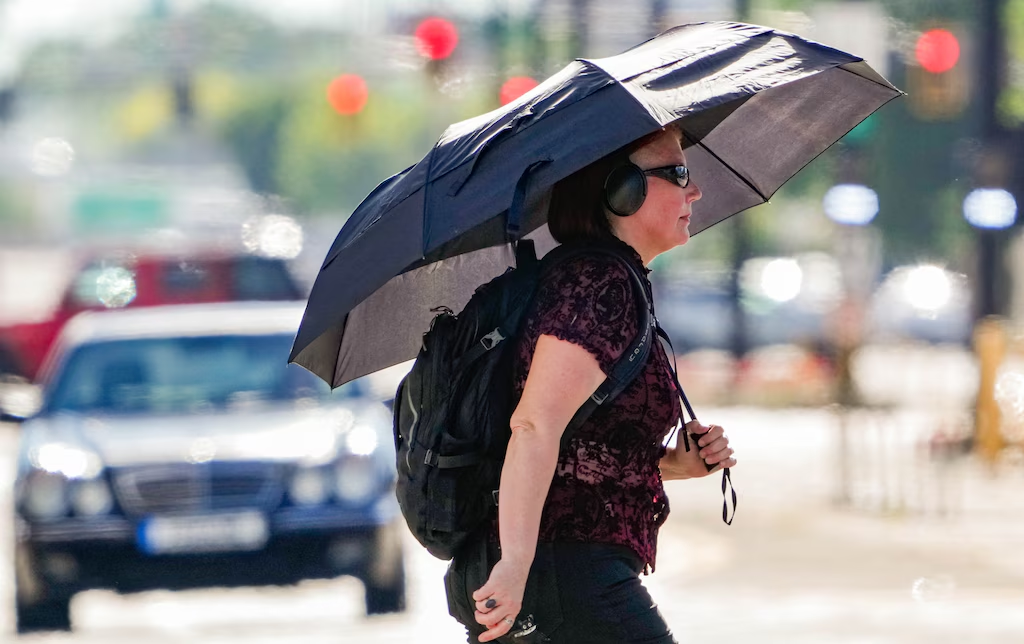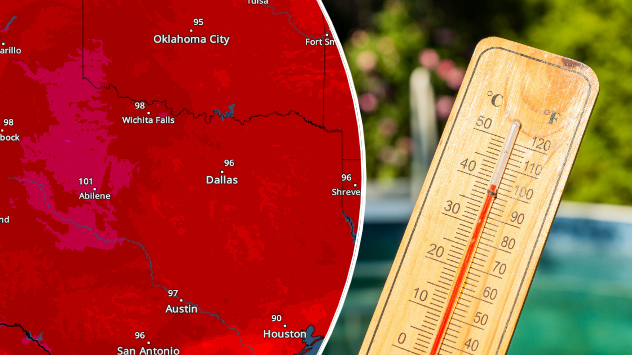The ongoing heat wave has shattered temperature records in several cities including Dallas, Austin, and San Antonio. On Monday, the National Weather Service reported highs of 106°F in central Texas, with “feels-like” temperatures reaching up to 112°F due to humidity.
According to the National Weather Service Texas Office, this stretch of hot weather is likely to continue throughout the week, with little relief in sight.
“This is not your average summer heat,” said meteorologist Jordan Walker. “These are dangerous conditions, especially for vulnerable groups like the elderly, children, and outdoor workers.”
Drought Conditions Worsen as Heat Wave Drags On
The extreme temperatures are not only uncomfortable—they’re also having a damaging impact on the environment. Texas is experiencing worsening drought conditions, with reservoirs shrinking and crops under stress.

The U.S. Drought Monitor classifies large portions of West and Central Texas under “severe” to “extreme” drought.
Farmers across the region are expressing concern over reduced water availability and increased irrigation costs. “We’re seeing cracked soil and wilted plants even with constant watering,” said Hector Ramirez, a farmer in the Rio Grande Valley.
Power Grid Faces High Demand Pressure
With temperatures rising, electricity demand has skyrocketed. The Electric Reliability Council of Texas (ERCOT) reported a record-high electricity usage as millions of residents rely on air conditioning to keep cool.
To avoid outages, ERCOT has issued conservation requests and urged consumers to limit electricity usage during peak hours—between 3 p.m. and 8 p.m. Residents are being asked to raise thermostats to 78°F, avoid using large appliances, and turn off unnecessary lights.
ERCOT is also working closely with the Texas Department of Emergency Management to ensure grid reliability during this weather crisis.
Health Officials Warn of Heat-Related Illnesses
Texas hospitals are seeing a spike in heat-related illnesses, including heat exhaustion and heat stroke. In some counties, emergency room visits for heat symptoms have doubled compared to last year.
Public health officials recommend staying hydrated, avoiding outdoor activity during peak heat, and checking on vulnerable neighbors.
“Even 10 minutes of exposure in this heat can cause serious health issues,” said Dr. Maria Ellis from the Texas Health and Human Services Commission. “Heat stroke can be deadly if not treated quickly.”
Residents are encouraged to visit local cooling centers, which have been set up in public libraries, community centers, and churches. The Texas Department of State Health Services provides a list of cooling centers and safety tips.
Urban Centers Suffer From “Heat Island” Effect
Urban areas like Houston and Dallas are facing a double hit due to the “urban heat island” effect, where concrete and asphalt surfaces trap heat, causing city temperatures to be 5–10 degrees higher than surrounding rural areas.
Many city officials are pushing for long-term solutions, including more green spaces, tree planting, and reflective rooftops to combat this effect. “Cities need to adapt because extreme heat is becoming the new normal,” said urban planner Lisa Tran.
Wildfire Risk on the Rise
With parched land and high temperatures, Texas is also seeing a growing number of wildfires. The Texas A&M Forest Service has raised the wildfire alert to “Very High” for much of the western part of the state.

Over 15 new wildfires were reported in the past 48 hours alone, burning more than 5,000 acres. Firefighters are working overtime, but with gusty winds and dry brush, the risk continues to rise.
Visit the Texas A&M Forest Service Fire Information Page for updates on current fire activity and safety alerts.
Tips to Stay Safe During the Heat Wave
Officials are urging residents to take basic but essential precautions:
- Drink plenty of water – even if you’re not thirsty
- Avoid outdoor activities during peak heat hours
- Never leave children or pets in cars
- Wear light-colored, loose-fitting clothing
- Use fans and air conditioning whenever possible
- Take frequent breaks if you work outside
These simple steps can make a big difference in preventing heat-related emergencies.
Long-Term Climate Warnings
Experts warn that this heat wave may be part of a longer trend linked to climate change. Texas has seen increasingly frequent and severe heat events in recent years.
Climate scientists are urging policymakers to invest in infrastructure and public health strategies that can help the state adapt to a warmer future.
“There’s no doubt we are seeing the fingerprints of climate change in these heat events,” said Dr. Anjali Desai from the University of Texas Climate Center.
Conclusion
As the Texas heat wave intensifies, the immediate focus is on survival—staying cool, safe, and hydrated. But this crisis is also a stark reminder that extreme weather is no longer an occasional disruption; it’s becoming part of the everyday reality in Texas.
With triple-digit temperatures predicted to linger, the time to prepare, adapt, and act is now.
For ongoing weather alerts, resources, and updates, visit the National Weather Service – Texas or check in with your local emergency management office.
Also Read – Washington’s Sky Opens Up: Drought Crisis Finally Eased





